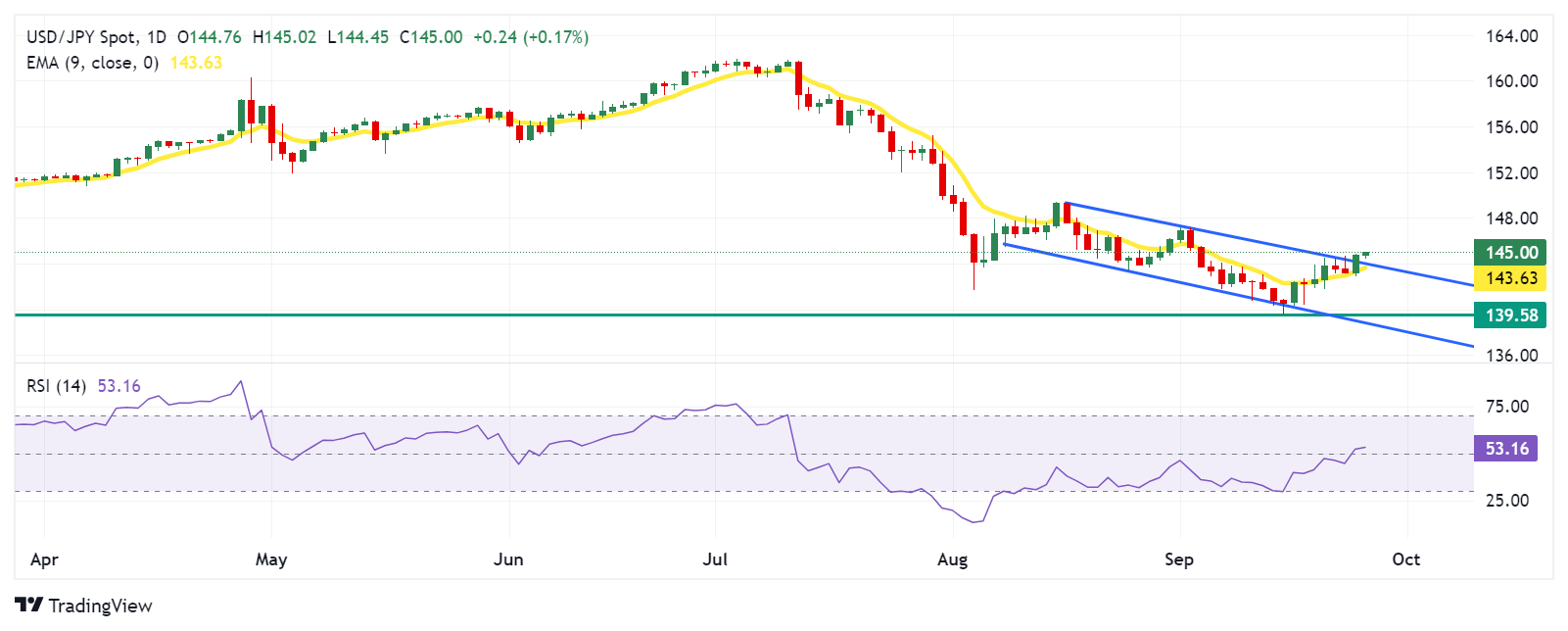- The Japanese Yen is under downward pressure as traders expect the BoJ to further delay rate hikes.
- Minutes of the BoJ meeting highlighted a consensus among members on the need to remain vigilant regarding inflation risks.
- Traders are awaiting the U.S. annualized gross domestic product for the second quarter, scheduled for Thursday.
The Japanese Yen (JPY) remains subdued against the US Dollar (USD) following the release of the minutes from the Bank of Japan (BoJ) July monetary policy meeting on Thursday. The JPY faces challenges as traders expect the BoJ to reflect before making further rate hikes.
The minutes of the BoJ’s policy meeting expressed a consensus among members on the importance of remaining vigilant regarding risks of inflation overshooting targets. Several members indicated that raising rates to 0.25% would be appropriate as a way of adjusting the level of monetary support. Some others suggested that a moderate adjustment to monetary support would also be appropriate.
The US dollar is under downward pressure from increasing odds of further interest rate cuts by the US Federal Reserve (Fed) at upcoming policy meetings. According to the CME FedWatch tool, markets are pricing in around a 50% chance of a total of 75 basis points of Fed cuts to a range of 4.0-4.25% by the end of this year.
Traders are now focused on the release of the final annualized US gross domestic product (GDP) for the second quarter (Q2) scheduled for release later in the day. Tokyo inflation data will be watched on Friday, which could provide further guidance on the economic outlook and possible monetary policy moves by the Bank of Japan.
Daily Market Wrap: Japanese Yen Weakens on Concerns Over BoJ’s Delay in Rate Hikes
- Federal Reserve Governor Adriana Kugler said Wednesday that she “strongly supported” the Fed’s decision to cut interest rates by half a point last week. Kugler also said that additional rate cuts will be appropriate if inflation continues to decline as expected, according to Bloomberg.
- Federal Reserve Governor Michelle Bowman said Tuesday that key inflation indicators are still “uncomfortably above” the 2% target, urging caution as the Fed moves forward with interest rate cuts. Despite this, she expressed a preference for a more conventional approach, advocating a quarter-percentage point reduction.
- The US Consumer Confidence Index fell to 98.7 in September from a revised 105.6 in August. This figure marked the largest drop since August 2021.
- On Tuesday, BoJ Governor Kazuo Ueda indicated that the central bank has time to assess market and economic conditions before making any policy adjustments, noting that there is no urgency to raise interest rates again. Ueda also noted that Japan’s real interest rate remains deeply negative, which is helping to stimulate the economy and boost prices.
- Minneapolis Fed President Neel Kashkari said on Monday that he believes there should and will be additional interest rate cuts in 2024. However, Kashkari expects future cuts to be smaller than the one at the September meeting, according to Reuters.
- Chicago Fed President Austan Goolsbee noted, “Many more rate cuts are likely to be needed next year, rates need to come down significantly.” Additionally, Atlanta Fed President Raphael Bostic said the U.S. economy is close to normal rates of inflation and unemployment and the central bank needs monetary policy to “normalize” as well, according to Reuters.
- On Monday, Japan’s new “chief currency diplomat” Atsushi Mimura said in an interview with NHK that the yen carry trades accumulated in the past have likely been mostly liquidated. Mimura warned that if such trades were to increase again, it could lead to further market volatility. “We are always monitoring the markets to make sure that doesn’t happen,” he added.
Technical Analysis: USD/JPY breaks above descending channel towards 145.00
USD/JPY is trading around 145.00 on Thursday. The daily chart analysis shows that the pair has broken above the descending channel, indicating a potential weakening of the bearish bias. Moreover, the 14-day Relative Strength Index (RSI) has moved above the 50 level, suggesting a momentum shift from bearish to bullish.
On the upside, the USD/JPY pair could explore the region around its six-week high of 149.40.
In terms of support, the USD/JPY pair could test the immediate upper boundary of the descending channel, around the 144.00 level, followed by the nine-day exponential moving average (EMA) at the 143.62 level. A return to the descending channel would reinforce the bearish bias and lead the pair to target the 139.58 region, the lowest point since June 2023.
USD/JPY: Daily Chart
Japanese Yen PRICE Today
The table below shows the Japanese Yen (JPY) exchange rate against major currencies today. The Japanese Yen was the weakest currency against the Australian Dollar.
| USD | EUR | GBP | JPY | CAD | AUD | NZD | CHF | |
|---|---|---|---|---|---|---|---|---|
| USD | -0.07% | -0.12% | 0.04% | -0.10% | -0.33% | -0.07% | -0.03% | |
| EUR | 0.07% | -0.05% | 0.08% | -0.03% | -0.26% | 0.00% | 0.06% | |
| GBP | 0.12% | 0.05% | 0.14% | 0.02% | -0.20% | 0.04% | 0.08% | |
| JPY | -0.04% | -0.08% | -0.14% | -0.12% | -0.37% | -0.12% | -0.09% | |
| CAD | 0.10% | 0.03% | -0.02% | 0.12% | -0.22% | 0.04% | 0.07% | |
| AUD | 0.33% | 0.26% | 0.20% | 0.37% | 0.22% | 0.27% | 0.31% | |
| NZD | 0.07% | -0.00% | -0.04% | 0.12% | -0.04% | -0.27% | 0.02% | |
| CHF | 0.03% | -0.06% | -0.08% | 0.09% | -0.07% | -0.31% | -0.02% |
The heatmap shows percentage changes of major currencies. The base currency is selected from the left column, while the quote currency is selected from the top row. For example, if you choose the Japanese Yen from the left column and move along the horizontal line to the US Dollar, the percentage change shown in the chart will represent the JPY (base)/USD (quote).
Japanese Yen FAQs
The Japanese Yen (JPY) is one of the most traded currencies in the world. Its value is determined broadly by the performance of the Japanese economy, but more specifically by the policy of the Bank of Japan, the spread between Japanese and US bond yields, and risk sentiment among traders, among other factors.
One of the Bank of Japan’s mandates is currency control, so its moves are key to the Yen. The BoJ has intervened directly in currency markets on occasion, usually to lower the value of the Yen, although it often refrains from doing so due to political concerns of its major trading partners. The BoJ’s current ultra-loose monetary policy, based on massive stimulus to the economy, has caused the Yen to depreciate against its major currency peers. This process has been exacerbated more recently by a growing policy divergence between the BoJ and other major central banks, which have opted to sharply raise interest rates to combat decades-old levels of inflation.
The Bank of Japan’s stance of maintaining an ultra-loose monetary policy has led to an increase in policy divergence with other central banks, in particular with the US Federal Reserve. This favours the widening of the spread between US and Japanese 10-year bonds, which favours the Dollar against the Yen.
The Japanese Yen is often considered a safe haven investment. This means that in times of market stress, investors are more likely to put their money into the Japanese currency due to its perceived reliability and stability. In turbulent times, the Yen is likely to appreciate against other currencies that are considered riskier to invest in.
Source: Fx Street
I am Joshua Winder, a senior-level journalist and editor at World Stock Market. I specialize in covering news related to the stock market and economic trends. With more than 8 years of experience in this field, I have become an expert in financial reporting.








